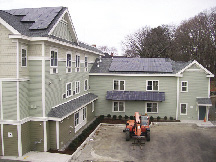Landmark Structures Corp. recently completed Massachusetts' first Platinum LEED for Homes Low-rise Multi-family residence*. The 32-unit project, located at 325 Cabot St., attained the highest possible level within the LEED rating system. The ribbon cutting on April 15 2011 was organized by North Shore Community Development Coalition of Salem, and included acknowledgements to the project team and a few proud words from the city's mayor. The building was already partially occupied at the time of the ceremony, with more residents coming soon, so only a partial tour of the interior of the building was available.
The crowd that gathered in the building's community room and kitchen grew so large that the ceremony was moved outside. Prior to moving outside, attendees were able to monitor the power production of the photovoltaic solar panels on the roof and south facing window awnings by viewing a display in the community room that receives real-time power production information. The display is part of the green building educational component that helped the building earn LEED Platinum. The display will be useful for residents and guests to learn more about the building's green features behind the walls that are more difficult to see in a completed construction project.
Before renewable energy is considered, a primary method to creating green buildings is through energy load reduction. The industry standard for measuring building energy efficiency is the 'Home Energy Rating System' (HERS). Our LEED Platinum project has a HERS rating of 40, which means that it is 60% more energy efficient than a similar building built only to building code requirements. A well insulated envelope, as well as thorough and complete air-sealing, greatly reduces the required energy demands to maintain comfortable temperatures in the building. High-efficiency HVAC equipment is used to efficiently create that comfort.
In addition to energy concerns, green buildings must also have 'environmentally friendly' interior spaces. To create great indoor air quality, hard surface flooring is used throughout the building. All paints, adhesives, and sealants required for construction were Low / No VOC products. Stale air is continuously exhausted at a calibrated rate from each of the units' bathrooms and fresh air is continuously introduced to the building in the living spaces.
Saving water is also important for a variety of reasons, including that saving water translates to saving energy too. Potable water that is piped into our buildings has a lot of energy put into it to make it safe to drink and to pump it to our taps. After we use the water, a large percentage goes down the drain and must again use energy to pump and treat it at sewerage treatment plants. Our project at 325 Cabot St. reduces water use with high-efficiency faucets, toilets, and showerheads. Exterior water use is eliminated by installing drought-tolerant plants.
Utilizing panelized wood frame construction reduced the wood waste generated by the project and saves material required to complete the building. Cut-off waste in the factories is more easily saved and used as blocking for another panel. All the construction debris generated on-site was processed at recycling centers that extract reusable materials and diverted material from landfills.
The people at Landmark Structures are very proud to have built Massachusetts' first Platinum LEED for Homes Low-rise Multi-family residence, but we do not rest on our laurels. We already have our next registered LEED project underway!
*based on reviewing www.usgbc.org LEED for Homes Program Certified Projects List updated 04/28/2011
Tags:
Landmark Structures completes LEED Platinum for Homes Low-rise Multi-family
May 25, 2011 - Green Buildings








_opt1.jpg)